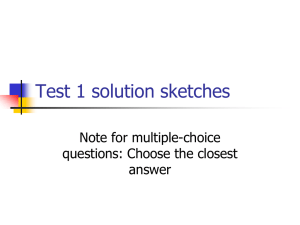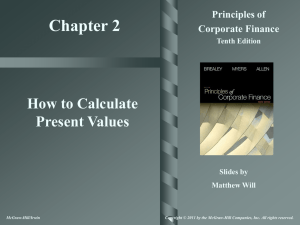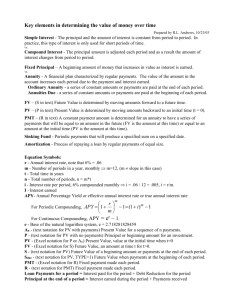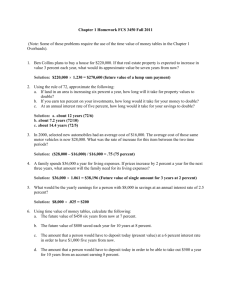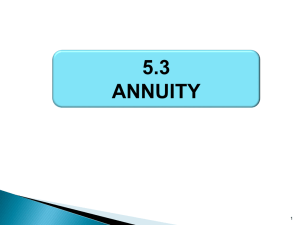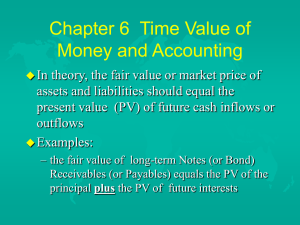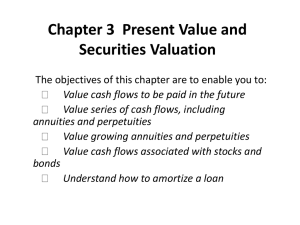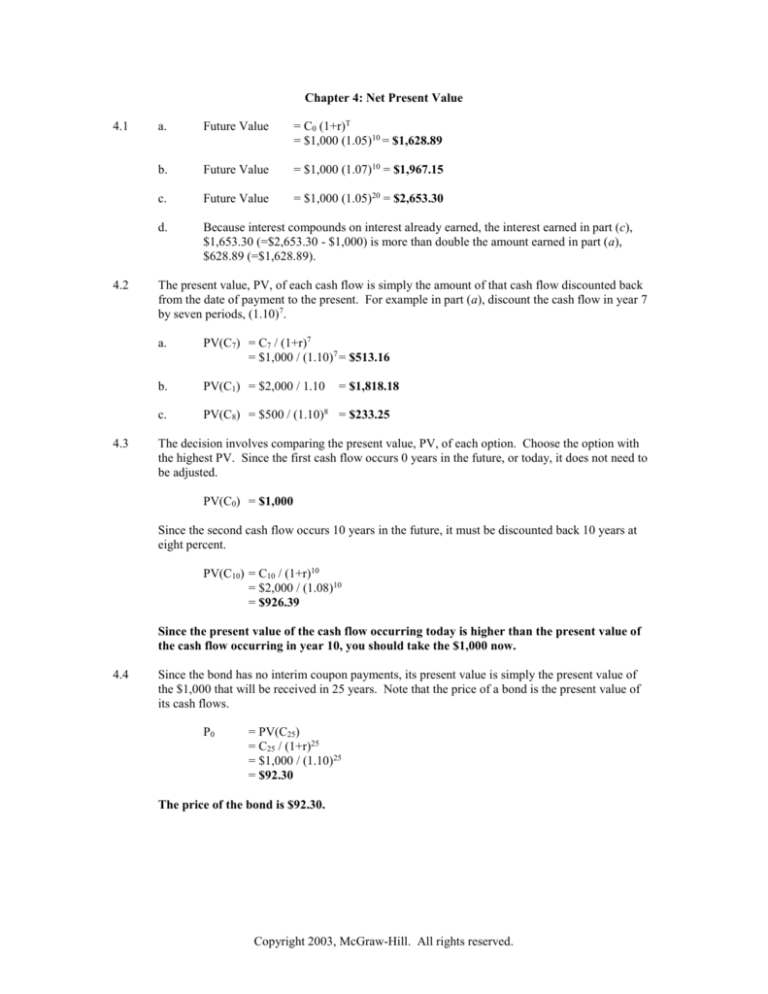
Chapter 4: Net Present Value
4.1
4.2
4.3
a.
Future Value
= C0 (1+r)T
= $1,000 (1.05)10 = $1,628.89
b.
Future Value
= $1,000 (1.07)10 = $1,967.15
c.
Future Value
= $1,000 (1.05)20 = $2,653.30
d.
Because interest compounds on interest already earned, the interest earned in part (c),
$1,653.30 (=$2,653.30 - $1,000) is more than double the amount earned in part (a),
$628.89 (=$1,628.89).
The present value, PV, of each cash flow is simply the amount of that cash flow discounted back
from the date of payment to the present. For example in part (a), discount the cash flow in year 7
by seven periods, (1.10)7.
a.
PV(C7) = C7 / (1+r)7
= $1,000 / (1.10)7 = $513.16
b.
PV(C1) = $2,000 / 1.10
c.
PV(C8) = $500 / (1.10)8 = $233.25
= $1,818.18
The decision involves comparing the present value, PV, of each option. Choose the option with
the highest PV. Since the first cash flow occurs 0 years in the future, or today, it does not need to
be adjusted.
PV(C0) = $1,000
Since the second cash flow occurs 10 years in the future, it must be discounted back 10 years at
eight percent.
PV(C10) = C10 / (1+r)10
= $2,000 / (1.08)10
= $926.39
Since the present value of the cash flow occurring today is higher than the present value of
the cash flow occurring in year 10, you should take the $1,000 now.
4.4
Since the bond has no interim coupon payments, its present value is simply the present value of
the $1,000 that will be received in 25 years. Note that the price of a bond is the present value of
its cash flows.
P0
= PV(C25)
= C25 / (1+r)25
= $1,000 / (1.10)25
= $92.30
The price of the bond is $92.30.
Copyright 2003, McGraw-Hill. All rights reserved.
4.5
The future value, FV, of the firm’s investment must equal the $1.5 million pension liability.
= C0 (1+r)27
FV
To solve for the initial investment, C0, discount the future pension liability ($1,500,000) back 27
years at eight percent, (1.08)27.
$1,500,000 / (1.08)27
= C0
= $187,780.23
The firm must invest $187,708.23 today to be able to make the $1.5 million payment.
4.6
The decision involves comparing the present value, PV, of each option. Choose the option with
the highest PV.
a.
At a discount rate of zero, the future value and present value of a cash flow are always
the same. There is no need to discount the two choices to calculate the PV.
PV(Alternative 1)
= $10,000,000
PV(Alternative 2)
= $20,000,000
Choose Alternative 2 since its PV, $20,000,000, is greater than that of Alternative 1,
$10,000,000.
b.
Discount the cash flows at 10 percent. Discount Alternative 1 back one year and
Alternative 2, five years.
PV(Alternative 1)
= C / (1+r)
= $10,000,000 / (1.10)1
= $9,090,909.10
PV(Alternative 2)
= $20,000,000 / (1.10)5
= $12,418,426.46
Choose Alternative 2 since its PV, $12,418,426.46, is greater than that of Alternative
1, $9,090,909.10.
c.
Discount the cash flows at 20 percent. Discount Alternative 1 back one year and
Alternative 2, five years.
PV(Alternative 1)
= C / (1+r)
= $10,000,000 / (1.20)1
= $8,333,333.33
PV(Alternative 2)
= $20,000,000 / (1.20)5
= $8,037,551.44
Choose Alternative 1 since its PV, $8,333,333.33, is greater than that of Alternative
2, $8,037,551.44.
d.
You are indifferent when the PVs of the two alternatives are equal.
Alternative 1, discounted at r
$10,000,000 / (1+r)1
= Alternative 2, discounted at r
= $20,000,000 / (1+r)5
Copyright 2003, McGraw-Hill. All rights reserved.
Solve for the discount rate, r, at which the two alternatives are equally attractive.
[1 / (1+r)1] (1+r)5
(1+r)4
1+r
r
= $20,000,000 / $10,000,000
=2
= 1.18921
= 0.18921 = 18.921%
The two alternatives are equally attractive when discounted at 18.921 percent.
4.7
The decision involves comparing the present value, PV, of each offer. Choose the offer with the
highest PV.
Since the Smiths’ payment occurs immediately, its present value does not need to be adjusted.
PV(Smith)
= $115,000
The Joneses’ offer occurs three years from today. Therefore, the payment must be discounted
back three periods at 10 percent.
PV(Jones)
= C3 / (1+r)3
= $150,000 / (1.10)3
= $112,697.22
Since the PV of the Joneses’ offer, $112,697.22, is less than the Smiths’ offer, $115,000, you
should choose the Smiths’ offer.
4.8
a.
Since the bond has no interim coupon payments, its present value is simply the present
value of the $1,000 that will be received in 20 years. Note that the price of the bond is
this present value.
P0
= PV(C20)
= C20 / (1+r)20
= $1,000 / (1.08)20
= $214.55
The current price of the bond is $214.55.
b.
To find the bond’s price 10 years from today, find the future value of the current price.
P10
= FV10
= C0 (1+r)10
= $214.55 (1.08)10
= $463.20
The bond’s price 10 years from today will be $463.20.
c.
To find the bond’s price 15 years from today, find the future value of the current price.
P15
= FV15
= C0 (1+r)15
= $214.55 (1.08)15
= $680.59
The bond’s price 15 years from today will be $680.59.
Copyright 2003, McGraw-Hill. All rights reserved.
4.9
Ann Woodhouse would be willing to pay the present value of its resale value.
PV
= $5,000,000 / (1.12)10
= $1,609,866.18
The most she would be willing to pay for the property is $1,609,866.18.
4.10
a.
Compare the cost of the investment to the present value of the cash inflows. You should
make the investment only if the present value of the cash inflows is greater than the cost
of the investment. Since the investment occurs today (year 0), it does not need to be
discounted.
PV(Investment)
= $900,000
PV(Cash Inflows)
= $120,000 / (1.12) + $250,000 / (1.12) 2 + $800,000 / (1.12)3
= $875,865.52
Since the PV of the cash inflows, $875,865.52, is less than the cost of the investment,
$900,000, you should not make the investment.
b.
The net present value, NPV, is the present value of the cash inflows minus the cost of the
investment.
NPV
= PV(Cash Inflows) – Cost of Investment
= $875,865.52 – $900,000
= -$24,134.48
The NPV is -$24,134.48.
c.
Calculate the PV of the cash inflows, discounted at 11 percent, minus the cost of the
investment. If the NPV is positive, you should invest. If the NPV is negative, you
should not invest.
NPV
= PV(Cash Inflows) – Cost of Investment
= $120,000 / (1.11) + $250,000 / (1.11) 2 + $800,000 / (1.11)3 – $900,000
= -$4,033.18
Since the NPV is still negative, -$4,033.18, you should not make the investment.
4.11
Calculate the NPV of the machine. Purchase the machine if it has a positive NPV. Do not
purchase the machine if it has a negative NPV.
Since the initial investment occurs today (year 0), it does not need to be discounted.
PV(Investment) = -$340,000
Discount the annual revenues at 10 percent.
PV(Revenues)
= $100,000 / (1.10) + $100,000 / (1.10) 2 + $100,000 / (1.10)3 +
$100,000 / (1.10)4 + $100,000 / (1.10)5
= $379,078.68
Since the maintenance costs occur at the beginning of each year, the first payment is not
discounted. Each year thereafter, the maintenance cost is discounted at an annual rate of 10
percent.
Copyright 2003, McGraw-Hill. All rights reserved.
PV(Maintenance) = -$10,000 - $10,000 / (1.10) - $10,000 / (1.10)2 - $10,000 / (1.10)3 –
$10,000 / (1.10)4
= -$41,698.65
NPV
= PV(Investment) + PV(Cash Flows) + PV(Maintenance)
= -$340,000 + $379,078.68 - $41,698.65
= -$2,619.97
Since the NPV is negative, -$2,619.97, you should not buy the machine.
To find the NPV of the machine when the relevant discount rate is nine percent, repeat the above
calculations, with a discount rate of nine percent.
PV(Investment) = -$340,000
Discount the annual revenues at nine percent.
PV(Revenues)
= $100,000 / (1.09) + $100,000 / (1.09) 2 + $100,000 / (1.09)3 +
$100,000 / (1.09)4 + $100,000 / (1.09)5
= $388,965.13
Since the maintenance costs occur at the beginning of each year, the first payment is not
discounted. Each year thereafter, the maintenance cost is discounted at an annual rate of nine
percent.
PV(Maintenance) = -$10,000 - $10,000 / (1.09) - $10,000 / (1.09)2 - $10,000 / (1.09)3 –
$10,000 / (1.09)4
= -$42,397.20
NPV
= PV(Investment) + PV(Cash Flows) + PV(Maintenance)
= -$340,000 + $388,965.13 - $42,397.20
= $6,567.93
Since the NPV is positive, $6,567.93, you should buy the machine.
4.12
a.
The NPV of the contract is the PV of the item’s revenue minus its cost.
PV(Revenue)
= C5 / (1+r)5
= $90,000 / (1.10)5
= $55,882.92
NPV
= PV(Revenue) – Cost
= $55,882.92 - $60,000
= -$4,117.08
The NPV of the item is -$4,117.08.
b.
The firm will break even when the item’s NPV is equal to zero.
NPV
$0
r
= PV(Revenues) – Cost
= C5 / (1+r)5 – Cost
= $90,000 / (1+r)5 - $60,000
= 0.08447 = 8.447%
The firm will break even on the item with an 8.447 percent discount rate.
Copyright 2003, McGraw-Hill. All rights reserved.
4.13
Compare the PV of your aunt’s offer with your roommate’s offer. Choose the offer with the
highest PV. The PV of your aunt’s offer is the sum of her payment to you and the benefit from
owning the car an additional year.
PV(Aunt)
= PV(Trade-In) + PV(Benefit of Ownership)
= $3,000 / (1.12) + $1,000 / (1.12)
= $3,571.43
Since your roommate’s offer occurs today (year 0), it does not need to be discounted.
PV(Roommate) = $3,500
Since the PV of your aunt’s offer, $3,571.43, is higher than your roommate’s offer, $3,500,
you should accept your aunt’s offer.
4.14
The cost of the car 12 years from today will be $80,000. To find the rate of interest such that your
$10,000 investment will pay for the car, set the FV of your investment equal to $80,000.
FV
= C0 (1+r)12
$80,000 = $10,000 (1+r)12
Solve for the interest rate, r.
8
= (1+r)12
0.18921 = r
The interest rate required is 18.921%.
4.15
The deposit at the end of the first year will earn interest for six years, from the end of year 1 to the
end of year 7.
FV
= $1,000 (1.12)6
= $1,973.82
The deposit at the end of the second year will earn interest for five years.
FV
= $1,000 (1.12)5
= $1,762.34
The deposit at the end of the third year will earn interest for four years.
FV
= $1,000 (1.12)4
= $1,573.52
The deposit at the end of the fourth year will earn interest for three years.
FV
= $1,000 (1.12)3
= $1,404.93
Combine the values found above to calculate the total value of the account at the end of the
seventh year:
FV
= $1,973.82 + $1,762.34 + $1,573.52 + $1,404.93
= $6,714.61
The value of the account at the end of seven years will be $6,714.61.
Copyright 2003, McGraw-Hill. All rights reserved.
4.16
To find the future value of the investment, convert the stated annual interest rate of eight percent
to the effective annual yield, EAY. The EAY is the appropriate discount rate because it captures
the effect of compounding periods.
a.
With annual compounding, the EAY is equal to the stated annual interest rate.
FV
= C0 (1+ EAY)T
= $1,000 (1.08)3
= $1,259.71
The future value is $1,259.71.
b.
Calculate the effective annual yield (EAY), where m denotes the number of compounding
periods per year.
EAY
= [1 + (r/m)]m – 1
= [1 + (0.08 / 2)]2 – 1
= 0.0816
Apply the future value formula, using the EAY for the interest rate.
FV
= C0 [1+EAY] 3
= $1,000 (1 + 0.0816)3
= $1,265.32
The future value is $1,265.32.
c.
Calculate the effective annual yield (EAY), where m denotes the number of compounding
periods per year.
EAY
= [1 + (r/m)]m – 1
= [1 + (0.08 / 12)]12 – 1
= 0.083
Apply the future value formula, using the EAY for the interest rate.
FV
= C0 (1+ EAY)3
= $1,000 (1 + 0.083)3
= $1,270.24
The future value is $1,270.24.
d.
Continuous compounding is the limiting case of compounding. The EAY is calculated as
a function of the constant, e, which is approximately equal to 2.718.
FV
= C0 erT
= $1,000 e0.083
= $1,271.25
The future value is $1,271.25.
e.
The future value of an investment increases as the compounding period shortens because
interest is earned on previously accrued interest payments. The shorter the compounding
period, the more frequently interest is paid, resulting in a larger future value.
Copyright 2003, McGraw-Hill. All rights reserved.
4.17
Continuous compounding is the limiting case of compounding. The future value is a function of
the constant, e, which is approximately equal to 2.718.
a.
FV
= C0 erT
= $1,000 e0.125
= $1,822.12
The future value is $1,822.12.
b.
FV
= $1,000 e0.103
= $1,349.86
The future value is $1,349.86.
c.
FV
= $1,000 e0.0510
= $1,648.72
The future value is $1,648.72.
d.
FV
= $1,000 e0.078
= $1,750.67
The future value is $1,750.67.
4.18
Convert the stated annual interest rate to the effective annual yield, EAY. The EAY is the
appropriate discount rate because it captures the effect of compounding periods. Next, discount
the cash flow at the EAY.
EAY
= [1+(r / m)]m – 1
= [1+(0.10 / 4)]4 – 1
= 0.10381
Discount the cash flow back 12 periods.
PV(C12) = C12 / (1+EAY)12
= $5,000 / (1.10381)12
= $1,528.36
The problem could also have been solved in a single calculation:
PV(C12) = CT / [1+(r / m)]mT
= $5,000 / [1+(0.10 / 4)]412
= $1,528.36
The PV of the cash flow is $1,528.36.
4.19
Deposit your money in the bank that offers the highest effective annual yield, EAY. The EAY is
the rate of return you will receive after taking into account compounding. Convert each bank’s
stated annual interest rate into an EAY.
EAY(Bank America)
= [1+(r / m)]m – 1
= [1+(0.041 / 4)]4 – 1
= 0.0416 = 4.16%
EAY(Bank USA)
= [1+(r / m)]m – 1
Copyright 2003, McGraw-Hill. All rights reserved.
= [1+(0.0405 / 12)]12 – 1
= 0.0413 = 4.13%
You should deposit your money in Bank America since it offers a higher EAY (4.16%) than
Bank USA offers (4.13%).
4.20
The price of any bond is the present value of its coupon payments. Since a consol pays the same
coupon every year in perpetuity, apply the perpetuity formula to find the present value.
PV
= C1 / r
= $120 / 0.15
= $800
The price of the consol is $800.
4.21
a.
Apply the perpetuity formula, discounted at 10 percent.
PV
= C1 / r
= $1,000 / 0.1
= $10,000
The PV is $10,000.
b.
Remember that the perpetuity formula yields the present value of a stream of cash flows
one period before the initial payment. Therefore, applying the perpetuity formula to a
stream of cash flows that begins two years from today will generate the present value of
that perpetuity as of the end of year 1. Next, discount the PV as of the end of 1 year back
one year, yielding the value today, year 0.
PV
= [C2 / r] / (1+r)
= [$500 / 0.1] / (1.1)
= $4,545.45
The PV is $4,545.45.
c.
Applying the perpetuity formula to a stream of cash flows that begins three years from
today will generate the present value of that perpetuity as of the end of year 2. Thus, use
the perpetuity formula to find the PV as of the end of year 2. Next, discount that value
back two years to find the value today, year 0.
PV
= [C3 / r] / (1+r)2
= [$2,420 / 0.1] / (1.1)2
= $20,000
The PV is $20,000.
4.22
Applying the perpetuity formula to a stream of cash flows that starts at the end of year 9 will
generate the present value of that perpetuity as of the end of year 8.
PV8
= [C9 / r]
= [$120 / 0.1]
= $1,200
To find the PV of the cash flows as of the end of year 5, discount the PV of the perpetuity as of the
end of year 8 back three years.
Copyright 2003, McGraw-Hill. All rights reserved.
PV5
= PV8 / (1+r)3
= $1,200 / (1.1)3
= $901.58
The PV as of the end of year 5 is $901.58.
4.23
Use the growing perpetuity formula. Since Harris Inc.’s last dividend was $3, the next dividend
(occurring one year from today) will be $3.15 (= $3 1.05). Do not take into account the
dividend paid yesterday.
PV
= C1 / (r – g)
= $3.15 / (0.12 – 0.05)
= $45
The price of the stock is $45.
4.24
Use the growing perpetuity formula to find the PV of the dividends. The PV is the maximum you
should be willing to pay for the stock.
PV
= C1 / (r – g)
= $1 / (0.1 – 0.04)
= $16.67
The maximum you should pay for the stock is $16.67.
4.25
The perpetuity formula yields the present value of a stream of cash flows one period before the
initial payment. Apply the growing perpetuity formula to the stream of cash flows beginning two
years from today to calculate the PV as of the end of year 1. To find the PV as of today, year 0,
discount the PV of the perpetuity as of the end of year 1 back one year.
PV
= [C2 / (r – g)] / (1+r)
= [$200,000 / (0.1 – 0.05)] / (1.1)
= $3,636,363.64
The PV of the technology is $3,636,363.64.
4.26
Barrett would be indifferent when the NPV of the project is equal to zero. Therefore, set the net
present value of the project’s cash flows equal to zero. Solve for the discount rate, r.
NPV
0
0.5
= Initial Investment + Cash Flows
= -$100,000 + $50,000 / r
=r
The discount rate at which Barrett is indifferent to the project is 50%.
4.27
Because the cash flows occur quarterly, they must be discounted at the rate applicable for a quarter
of a year. Since the stated annual interest rate is given in terms of quarterly periods, and the
payments are given in terms of quarterly periods, simply divide the stated annual interest rate by
four to calculate the quarterly interest rate.
Quarterly Interest Rate
= Stated Annual Interest Rate / Number of Periods
= 0.12 / 4
= 0.03 = 3%
Use the perpetuity formula to find the PV of the security’s cash flows.
Copyright 2003, McGraw-Hill. All rights reserved.
PV
= C1 / r
= $10 / 0.03
= $333.33
The price of the security is $333.33.
4.28
The two steps involved in this problem are a) calculating the appropriate discount rate and b)
calculating the PV of the perpetuity.
Since the payments occur quarterly, the cash flows must be discounted at the interest rate
applicable for a quarter of a year.
Quarterly Interest Rate
= Stated Annual Interest Rate / Number of Periods
= 0.15 / 4
= 0.0375 = 3.75%
Remember that the perpetuity formula provides the present value of a stream of cash flows one
period before the initial payment. Therefore, applying the perpetuity formula to a stream of cash
flows that begins 20 periods from today will generate the present value of that perpetuity as of the
end of period 19. Next, discount that value back 19 periods, yielding the price today, year 0.
= [C20 / r] / (1+r)19
= [$1 / 0.0375] / (1.0375)19
= $13.25
PV
The price of the stock is $13.25.
4.29
Calculate the NPV of the asset. Since the cash inflows form an annuity, you can use the present
value of an annuity factor. The annuity factor is referred to as ATr, where T is the number of
payments and r is the interest rate.
PV(Investment)
= -$6,200
PV(Cash Inflows)
= C A Tr
= $1,200 A80.1
= $6,401.91
The NPV of the asset is the sum of the initial investment (-$6,200) and the PV of the cash inflows
($6,401.91).
NPV
= -Initial Investment + Cash Flows
= -$6,200 + $6,401.91
= $201.91
Since the asset has a positive NPV, $201.91, you should buy it.
4.30
There are 20 payments for an annuity beginning in year 3 and ending in year 22. Apply the
annuity formula to this stream of 20 annual payments.
PV(End of Year 2)
= C A Tr
= $2,000 A200.08
= $19,636.29
Since the first cash flow is received at the end of year 3, applying the annuity formula to the cash
flows will yield the PV as of the end of year 2. To find the PV as of today, year 0, discount that
amount back two years.
Copyright 2003, McGraw-Hill. All rights reserved.
PV(Year 0)
= PV(End of Year 2) / (1+r)T
= $19,636.29 / (1.08)2
= $16,834.95
The PV of the cash flows is $16,834.95.
4.31
There are 15 payments for an annuity beginning in year 6 and ending in year 20. Apply the
annuity formula to this stream of 15 annual payments.
PV(End of Year 5)
= C A Tr
= $500 A150.15
= $2,923.69
Since the first cash flow is received at the end of year 6, applying the annuity formula to the cash
flows will yield the PV as of the end of year 5. To find the PV as of today, year 0, discount that
amount back five years at 12 percent.
PV(Year 0)
= PV(End of Year 5) / (1.12)5
= $2,923.69 / (1.12)5
= $1,658.98
The PV of the annuity is $1,658.98.
4.32
Set the price of the note equal to the present value of the annuity of $2,000 per year.
= C ATr
= $2,000 A10r
P
$12,800
The problem can be solved by using a calculator to find the appropriate discount rate.
6.4
0.090626
= A10r
=r
The problem can also be solved by using table A.2 in the back of the textbook. In table A.2, scan
across the row for 10-year annuity factors until one approximates 6.4. 6.4177, corresponding to a
rate of 9%, is close to the above factor, 6.4. Thus, the rate received is slightly more than 9%.
The rate received is 9.0626%.
4.33
a.
To calculate the necessary annual payments, first find the PV of the $25,000 which you
will need in five years.
PV
= C5 / (1+r)5
= $25,000 / (1.07)5
= $17,824.65
Next, compute the annuity that will yield the same PV as calculated above. Solve for the
deposit you will make each year.
PV
$17,824.65
$17,824.65 / A50.07
= C A Tr
= C A50.07
= $4,347.27
Depositing $4,347.27 into the 7% account each year will provide $25,000 five years
from today.
Copyright 2003, McGraw-Hill. All rights reserved.
b.
The lump sum payment must be the present value of the $25,000 you will need five years
from today.
PV
= C5 / (1+r)5
= $25,000 / (1.07)5
= $17,824.65
You must deposit $17,824.65 as a lump sum to have $25,000 in the account at the
end of five years.
4.34
First, determine the balance of the loan Nancy must pay.
Balance = $120,000 (0.85)
= $102,000
Apply the annuity formula since Nancy will pay the balance of the loan in 20 equal, end-of-year,
payments. Set the present value of the annuity equal to the balance of the loan. Solve for the
annual payment, C.
Balance
$102,000
$102,000 / A200.1
$11,980.88
= C A Tr
= C A200.1
=C
=C
The equal installments are $11,980.88.
4.35
a.
The cash flows form a 31-year annuity where the first payment is received today.
Remember to use the after-tax cash flows. The first payment of a standard annuity is
received one year from today. Therefore, value all after-tax cash flows except the first
after-tax payment using the standard annuity formula. Then add back the first after-tax
payment to obtain the value of the option. Since the first payment is treated separately
from the other payments, the annuity has 30 periods instead of 31 periods.
PV
b.
= (1 – Tc) C1 ATr + (1 – Tc) C0
= (1 – 0.28) $160,000 A300.1 + (1 – 0.28) $160,000
= $1,201,180.55
This option pays $446,000, after-tax, immediately. The remaining money is received as a
30-year annuity that pays $101,055, annually before tax. Find the PV of the annuity,
discounted at 10 percent. Remember to apply taxes to the annuity.
PV
= (1 – Tc) C1 ATr + C0
= (1 – 0.28) $101,055 A300.1 + $446,000
= $1,131,898.53
Choose the first option with a PV of $1,201,180.55 since it has a higher PV than the second
option, $1,131.898.53.
Copyright 2003, McGraw-Hill. All rights reserved.
4.36
First, use the standard annuity formula to compute the present value of all the payments you must
make for each of your children’s educations.
PV(Each Child’s Education)
= C A Tr
= $21,000 A40.15
= $59,954.55
The annuity formula values any annuity as of one year before the first cash flow. Since the first
payment for each child is made when the child enters college, the above value represents the cost
of the older child’s education 14 years from now and of the younger child’s education 16 years
from now. To find the PV of the children’s education at year 0, discount the above PV back 14
years and 16 years for both the older and younger child, respectively.
PV(Older Child)
= PV(Education) / (1+r)14
= $59,954.55 / (1.15)14
= $8,473.30
PV(Younger Child)
= $59,954.55 / (1.15)16
= $6,407.03
PV(Total Cost)
= PV(Older Child )+ PV(Younger Child)
= $8,473.30 + $6,407.03
= $14,880.32
You will make 15 payments, since your first payment is made one year from today and the last
payment is made when your first child enters college, 15 years from now. To find the amount of
each payment, set the total PV of the children’s education costs equal to a 15-year annuity,
discounted at 15 percent. Solve for the annual payment, C.
PV(Total Cost)
$14,880.32
$14,880.32 / A150.15
$2,544.79
= C A Tr
= C A150.15
=C
=C
The annual payment that will allow you to pay for the total cost of your children’s college
educations in 15 years is $2,544.79.
4.37
To determine whether or not the policy is worth buying, calculate the NPV of the policy. The
parent’s six payments are cash outflows and the insurance company’s payment is a cash inflow.
The PV of the parent’s payments can be calculated by applying the annuity formula, discounted at
six percent, to both the first three payments (each $750) and the last three payments (each $800).
PV(First 3 Payments)
= C1 ATr
= -$750 A30.06
= -$2,004.76
The annuity formula calculates the PV as of one period prior to the first cash flow. Since the first
$800 payment occurs four years from today, the PV of the annuity of the last three payments must
be discounted back three years.
PV(Last 3 Payments)
= [C4 ATr] / (1+r)3
= [-$800 A30.06] / (1.06)3
= -$1,795.45
Discount the insurance company’s payment back 65 years. Take note that the discount rate is six
percent for years 1 through 6 and seven percent for years 7 through 65.
Copyright 2003, McGraw-Hill. All rights reserved.
PV(Insurance Payment)
NPV
= C65 / [(1+r)Year 1 - 6 (1+r)Year 7 – 65]
= $250,000 / [(1.06)6 (1.07)59]
= $3,254.33
= PV(First 3 Payments) + PV(Last 3 Payments) + PV(Insurance Payment)
= -$2,004.76 + -$1,795.45 + $3,254.33
= -$545.88
Since the NPV of the policy is negative, -$545.88, it is not worth buying.
4.38
Calculate the present value of the lease offer. An annuity in advance is a stream of cash flows
beginning today. Since the annual lease payments form an annuity in advance, value all payments
except the one made today using the standard annuity formula. Add back the payment made
today. The immediate payment is not discounted because it occurs today, year 0. Because the
first payment is treated separately, the annuity has nine periods instead of 10 periods.
PV(Payments)
= C0 + C1 ATr
= -$15,000 + -$15,000 A90.08
= -$108,703.32
PV(Purchase Option)
= CT / (1+r)T
= -$25,000 / (1.08)10
= -$11,579.84
PV(Lease)
= PV(Payments) + PV(Purchase Option)
= -$108,703.32 - $11,579.84
= -$120,283.16
Since the PV of the lease offer is greater than $120,000, the cost of the machine, you should
not accept the offer.
4.39
Remember that your salary grows by four percent each year, and you just received a $50,000
salary payment. Thus, your salary next year will be $52,000 (=$50,000 1.04). Two percent of
next year’s salary will be deposited into the account.
C
= (Last Year’s Salary) (1+g) (Percent Deposited)
= ($50,000) (1.04) (0.02)
= $1,040.00
Since your salary will continue to grow at four percent annually, your deposits will also grow at
this rate. Apply the growing annuity formula, discounted at eight percent, to calculate the PV of
your retirement account.
PV
= C GATr,g *
= $1,040.00 GA400.08, 0.04
= $20,254.12
To determine how much will be in the account at your retirement in 40 years, calculate the future
value.
FV
= PV (1+r)T
= $20,254.12 (1.08)40
= $440,011.02
At the time of your retirement, the account will have $440,011.02.
Copyright 2003, McGraw-Hill. All rights reserved.
The notation GATr, g represents a growing annuity consisting of T payments growing at a rate of g
per payment, discounted at r.
4.40
Discount the individual cash flows to compute the NPV of the project. The cash flow, C0, is the
initial investment.
PV(C0)
PV(C1)
PV(C2)
PV(C3)
PV(C4)
PV(C5)
PV(C6)
PV(C7)
PV(C8)
= -$5,000
= $700 / (1.1)
= $900 / (1.1)2
= $1,000 / (1.1)3
= $1,000 / (1.1)4
= $1,000 / (1.1)5
= $1,000 / (1.1)6
= $1,250 / (1.1)7
= $1,375 / (1.1)8
NPV
= -$5,000 + $636.36 + $743.80 + $751.32 + $683.01 + $620.92 + $564.47 +
$641.45 + $641.45
= $282.78
= $636.36
= $743.80
= $751.32
= $683.01
= $620.92
= $564.47
= $641.45
= $641.45
Purchase the machine since it has a positive NPV.
4.41
a.
Engineer:
Apply the annuity formula, discounted at five percent, to calculate the PV of his
undergraduate education.
PV(Undergraduate)
= C A Tr
= -$12,000 A40.05
= -$42,551.41
To find the PV of his practical experience in years 5 and 6, discount the two cash flows
by five years and six years, respectively.
PV(Experience) = $20,000 / (1.05)5 + $25,000 / (1.05)6
= $34,325.90
Discount the corresponding two cash flows for the master’s degree by seven years and
eight years.
PV(Master)
= -$15,000 / (1.05)7 + -$15,000 / (1.05)8
= -$20,812.81
After completion of his master’s degree, your brother will earn $40,000 per year for the
next 25 years. Since the annuity formula calculates the PV as of one year before the first
cash flow, applying the annuity formula to your brother’s future earnings will generate
the PV as of the end of year 8. Discount that PV back eight years to find the PV as of
today, year 0.
PV(Earnings)
= C9 ATr / (1+r)8
= $40,000 A250.05 / (1.05)8
= $381,573.46
Thus, the NPV of his decision to become an engineer is:
Copyright 2003, McGraw-Hill. All rights reserved.
NPV(Engineer) = PV(Undergraduate) + PV(Experience) + PV(Master) + PV(Earnings)
= -$42,551.41 + $34,325.90 – $20,812.81 + $381,573.46
= $352,535.14
Accountant:
Apply the annuity formula, discounted at five percent, to calculate the PV of the
accounting undergraduate education.
PV(Undergraduate)
= -$13,000 A40.05
= -$46,097.36
Apply the annuity formula to calculate the PV of the future earnings. Since the annuity
formula calculates the PV as of one year before the first cash flow, applying the annuity
formula to your brother’s future earnings will generate the PV as of the end of year 4.
Discount that PV back four periods to find the PV as of today.
PV(Earnings)
= C5 ATr / (1+r)4
= $31,000 A300.05 / (1.05)4
= $392,055.56
Thus, the NPV of his decision to become an accountant is:
NPV(Accountant)
= PV(Undergraduate) + PV(Earnings)
= -$46,097.36 + $392,055.56
= $345,958.20
Since the NPV of becoming an engineer, $352,535.14, is higher than the NPV of
becoming an accountant, $345,958.20, your brother should study engineering.
b.
After your brother announces that the appropriate discount rate is six percent, recalculate
the NPVs the same way as above, using a six percent discount rate.
NPV(Engineer)
= PV(Undergraduate) + PV(Experience) + PV(Master)
+PV(Earnings)
= -$12,000 A40.06 + $20,000 / (1.06)5 + $25,000 / (1.06)6 –
$15,000 / (1.06)7 – $15,000 / (1.06)8 + $40,000 A250.06 / (1.06)8
= $292,418.30
NPV(Accountant)
= PV(Undergraduate) + PV(Earnings)
= -$13,000 A40.06 + $31,000 A300.06 / (1.06)4
= $292,947.73
Your brother made a poor decision. At a six percent rate, the NPV of becoming an
accountant, $292,947.73, is higher than the NPV of becoming an engineer,
292,418.30. Thus, he should have chosen to study accounting.
4.42
Use the growing annuity formula, discounted at 12 percent and growing at four percent, to find the
PV of Tom’s annual salary payments.
PV(Salary)
= C GATr, g *
= $35,000 GA250.12, 0.04
= $368,894.18
* The notation GATr, g represents a growing annuity consisting of T payments growing at a rate of
g per payment, discounted at r.
Copyright 2003, McGraw-Hill. All rights reserved.
The yearly bonuses are equal to 10 percent of his salary. Since his salary grows at four percent,
the annual bonus will also grow at four percent. Use the growing annuity formula, discounted at
12 percent and growing at four percent, to find the PV of Tom’s annual bonus payments.
PV(Bonus)
= (0.1) ($35,000) GA250.12, 0.04
= $36,889.42
Mr. Adams will also receive a signing bonus today.
PV(Signing)
= $10,000
PV(Offer)
= PV(Salary) + PV(Bonus) + PV(Signing)
= $368,894.18 + $36,889.42 + $10,000
= $415,783.60
The PV of the offer is $415,783.60.
4.43
Apply the growing annuity formula to find the PV of the cash flows.
PV(Cash Flows) = C GATr, g *
= $10,000 GA50.1, 0.07
= $43,041.91
Subtract the initial cost of $40,000 from the PV of the growing annuity to find the NPV of the
revision.
PV(Cost)
= -$40,000
NPV
= PV(Cash Flows) + PV(Cost)
= $43,041.91 – $40,000
= $3,041.91
Since the NPV of the revision is positive, $3,041.91, revise the textbook. The firm’s return on
the project will be greater than 10 percent since the NPV is positive.
* The notation GATr, g represents a growing annuity consisting of T payments growing at a rate of
g per payment, discounted at r.
4.44
First, find the PV of Ian’s retirement income and his cabin purchase. Since the first retirement
payment is made at the end of year 31, applying the annuity formula to the cash flows will yield
the PV as of the end of year 30. To find the PV as of today, year 0, discount that value back 30
periods.
PV(Retirement) = C31 ATr / (1+r)30
= $300,000 A200.07 / (1.07)30
= $417,511.53
Since the cabin is purchased at the end of year 10, discount that cash flow back 10 periods to find
the PV as of today, year 0.
PV(Cabin)
= $350,000 / (1.07)10
= $177,922.25
Next, find the PV of his annual savings from year 1 through year 10, using the annuity formula.
Copyright 2003, McGraw-Hill. All rights reserved.
PV(Savings)
= $40,000 A100.07
= $280,943.26
Find the difference between the PV of his savings from year 1 through year 10 and the total PV of
Ian’s two expenditures (retirement and cabin).
Difference
= PV(Savings) – [PV(Retirement) + PV(Cabin)]
= $280,943.26 – ($417,511.53 + $177,922.25)
= -$314,491.52
In present value terms, Ian must save an additional $314,491.52 in order to meet his objectives.
To determine the amount he must save from year 11 through year 30, set the PV of his savings
over this time period equal to the difference of $314,491.52. Since the annual savings will begin
11 years from today, discount the annuity back 10 periods. Solve for the amount Ian needs to save
each year, C.
Difference
$314,491.52
[$314,491.52 (1.07)10] / A200.07
$58,396.23
= C ATr / (1+r)10
= C A200.07 / (1.07)10
=C
=C
Ian needs to save $58,396.23 annually from year 11 to year 30 in order to meet his objectives.
4.45
Since Jack’s salary is paid monthly, the payments need to be discounted at the monthly interest
rate.
Monthly Interest Rate
= Stated Annual Interest Rate / Number of Periods
= 0.12 / 12
= 0.01
Next, calculate the PV of his monthly salary. Since he will receive 36 monthly payments (=12
payments per year 3 years), the PV is:
PV(Salary)
= C A Tr
= $5,000 A360.01
= $150,537.53
Next, calculate the PV of his bonuses. The end-of-year bonuses must be discounted at the
effective annual yield, EAY. The EAY is the appropriate discount rate because it captures the
effect of compounding periods. Find the EAY and then apply the annuity formula, discounted at
the EAY, to calculate the PV of the bonuses.
EAY
= [1+(r / m)]m – 1
= [1+(0.12 / 12)]12 – 1
= 0.12683 = 12.683%
PV(Bonus)
= C A Tr
= $10,000 A30.12683
= $23,739.20
PV(Contract)
= PV(Salary) + PV(Bonus)
= $150,537.53 + $23,739.20
= $174,276.73
The PV of the contract is $174,276.73.
Copyright 2003, McGraw-Hill. All rights reserved.
4.46
First, determine the balance of the loan.
Balance = $15,000 (0.80)
= $12,000
Convert the stated annual interest rate to a monthly interest rate since the payments are made
monthly.
Monthly Interest Rate
= Stated Annual Interest Rate / Number of Periods
= 0.08 / 12
= 0.0067
Set the balance of the loan equal to the present value of the annuity of 48 monthly payments,
discounted at 0.0067. Solve for the monthly payment, C.
= C A Tr
= C A480.0067
=C
=C
Balance
$12,000
$12,000 / A480.0067
$293.18
The monthly installments will be $293.18.
4.47
The balance of the loan is:
Balance = $10,000 – $1,000
= $9,000
Because the payments are made on a monthly basis, first calculate the monthly interest rate.
Monthly Interest Rate
= 0.096 / 12
= 0.008
Next, to find Susan’s monthly payments, set the balance of the loan equal to an annuity with 60
periods (=12 months 5 years), discounted at the monthly interest rate.
Balance
$9,000
$9,000 / A600.008
$189.46
= C A Tr
= C A600.008
=C
=C
To find the balance of the loan that Susan will prepay, first find the number of remaining
payments beginning with the November 1, 2002 payment. Since her first payment was made on
October 1, 2000, her payment on October 1, 2002 was her 25 th. Thus, she has 35 remaining
payments, including the immediate November, 2002 payment.
Each of the remaining 35 payments is $189.46. To find the PV, value all payments
except the impending November payment using the standard annuity formula. Then add back the
November payment to obtain the PV of her repayment. Since the November payment is treated
separately from the other payments, the annuity has 34 periods instead of 35 periods.
PV(Loan)
= C1 ATr + C0
= $189.46 A340.008 + 189.46
= $5,809.81
Susan also incurs a 1% penalty. Thus, the total repayment is:
Copyright 2003, McGraw-Hill. All rights reserved.
Repayment
= PV(Loan) (1+Penalty)
= $5,809.81 (1.01)
= $5,867.91
The total repayment is $5,867.91.
4.48
To find the PV of the flower purchases, you must first find the weekly interest rate and the weekly
growth rate. Divide both the stated annual interest rate and the stated annual growth rate by 52 to
calculate the weekly interest rate and weekly growth rate.
Weekly Interest Rate
= 0.104 / 52
= 0.002
Weekly Growth Rate
= 0.039 / 52
= 0.00075
Apply the growing annuity formula, discounted at 0.002 with payments growing at a rate of
0.00075 weekly, to find the PV of Joe’s commitment. The growing annuity has 1,560 periods
(=30 years 52 weeks).
PV
= C1 GATr, g *
= $5 GA1,5600.002, 0.00075
= $3,429.38
The PV of Joe DiMaggio’s commitment is $3,429.38.
*The notation GATr, g represents a growing annuity consisting of T payments growing at a rate of g
per payment, discounted at r.
4.49
Since Goose receives his first payment on July 1 and all later payments are made in one-year
intervals on July 1, discount the cash flows to July 1 of year 0 using the annual discount rate of
nine percent. Then use the six-month discount rate (0.044) to discount the cash flows back to
January of year 0.
The PVs of the guaranteed payments over the first six years are:
PV(C1)
PV(C2)
PV(C3)
PV(C4)
PV(C5)
PV(C6)
= $875,000 / (1.044)
= $650,000 / [(1.09) (1.044)]
= $800,000 / [(1.09)2 (1.044)]
= $1,000,000 / [(1.09)3 (1.044)]
= $1,000,000 / [(1.09)4 (1.044)]
= $300,000 / [(1.09)5 (1.044)]
= $838,122.61
= $571,197.58
= $644,965.51
= $739,639.35
= $678,568.21
= $186,761.89
Apply the annuity formula, discounted at nine percent, to find the PV of the 17 deferred payments
of $240,000 from 1990 through 2006. The annuity formula will calculate the PV of the cash flows
as of July 1, 1989. Discount that value back 5.5 periods to find the PV of the deferred payments
as of January 1984.
PV(Deferred Payments)
= C7 ATr / [(1+Six Month Rate) (1+Annual Rate)T]
= $240,000 A170.09 / [(1.044) (1.09)5]
= $1,276,499.81
Perform a similar calculation to find the PV of the 10 deferred payments of $125,000 from 2007
through 2016. The annuity formula will calculate the PV of the cash flows as of July 1, 2006.
Discount that value back 22.5 periods to find the PV of the deferred payments as of January 1984.
Copyright 2003, McGraw-Hill. All rights reserved.
PV(Deferred Payments 2) = $125,000 A100.09 / [(1.044) (1.09)22]
= $115,399.28
NPV(Contract)
= PV(C1) + PV(C2) + PV(C3) + PV(C4) + PV(C5) + PV(C6) +
PV(Deferred Payments 1) + PV(Deferred Payments 2)
= $838,122.61 + $571,197.58 + $644,965.51 + $739,639.35 +
$678,568.21 + $186,761.89 + $1,276,499.81 + $115,399.28
= $5,051,154.24
The PV of the contract is $5,051,154.24.
To find the equivalent annual salary from year 1984 through 1988, set the PV of the five-year
annuity equal to the PV of the contract.
PV(Contract)
$5,051,154.24
$5,051,154.24 / A50.09
$1,298,613.65
= C A Tr
= C A50.09
=C
=C
The equivalent annual salary from year 1984 through 1988 is $1,298,613.65.
4.50
First, calculate the monthly interest rate.
Monthly Interest Rate
= 0.08 / 12
= 0.0067
Mike’s balloon payment is the PV of the remaining mortgage payments as of the end of year 8.
To calculate the PV of the remaining payments, first calculate Mike’s monthly payment. Because
he had to make a 20 percent down payment, Mike borrows $320,000 (=$400,000 0.8). Set this
amount equal to a 360 period annuity (=30 years 12 monthly payments), discounted at the
monthly interest rate.
Loan
$320,000
$320,000 / A3600.0067
$2,356.98
= C A3600.0067
= C A3600.0067
=C
=C
At the end of the eighth year, Mike will have made 96 payments (=8 years 12 monthly
payments). Thus, he will have 264 remaining payments (=360 – 96). His balloon payment is the
PV of those remaining payments. Apply the annuity formula, discounted at 0.0067, to the 264
remaining monthly payments to find the PV of Mike’s balloon payment, as of the end of year 8.
PV(Balloon)
= $2,356.98 A2640.0067
= $291,439.54
The value of Mike’s balloon payment at the end of year 8 will be $291,439.54.
Copyright 2003, McGraw-Hill. All rights reserved.
4.51
First, calculate the monthly interest rate.
Monthly Interest Rate
= 0.12 / 12
= 0.01
Then set the PV of the lease payments equal to $4,000, the retail price of the equipment. Since the
first payment is due immediately, value all payments except the payment made today using the
standard annuity formula. Because the first payment is treated separately from the others, the
annuity has 23 periods instead of 24 periods. Add back the payment made immediately.
PV
$4,000
$4,000
$4,000 / (A230.01 + 1)
$186.43
= C A Tr + C
= C A230.01 + C
= C (A230.01 + 1)
=C
=C
The monthly lease payment will be $186.43.
4.52
The effective annual yield (EAY) is the appropriate discount rate because it captures the effect of
compounding periods. First calculate the EAY.
EAY
= [1+(r / m)]m – 1
= [1+(0.08 / 4)]4 – 1
= 0.0824
Next, discount the payments of the annuity. The first payment is made at the end of year 5. Since
the standard annuity formula calculates the PV of the cash flows as of one year before the first
payment, applying the formula will yield the PV as of the end of year 4. Discount that value back
four years to find the PV of the annuity as of today.
PV
= C5 ATr / (1+r)4
= $900 A100.0824 / (1.0824)4
= $4,352.43
The PV of the annuity is $4,352.43.
Copyright 2003, McGraw-Hill. All rights reserved.

